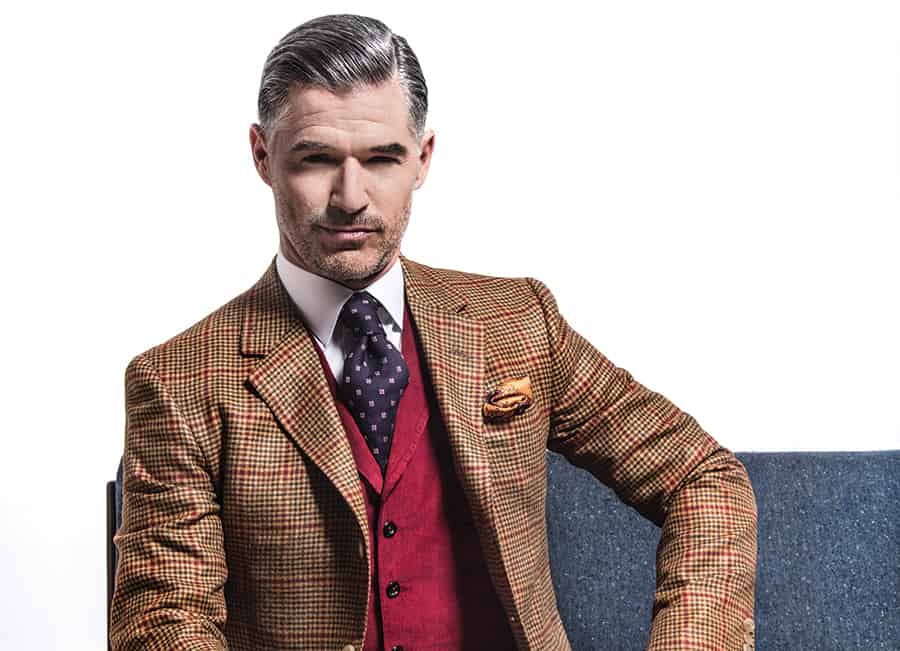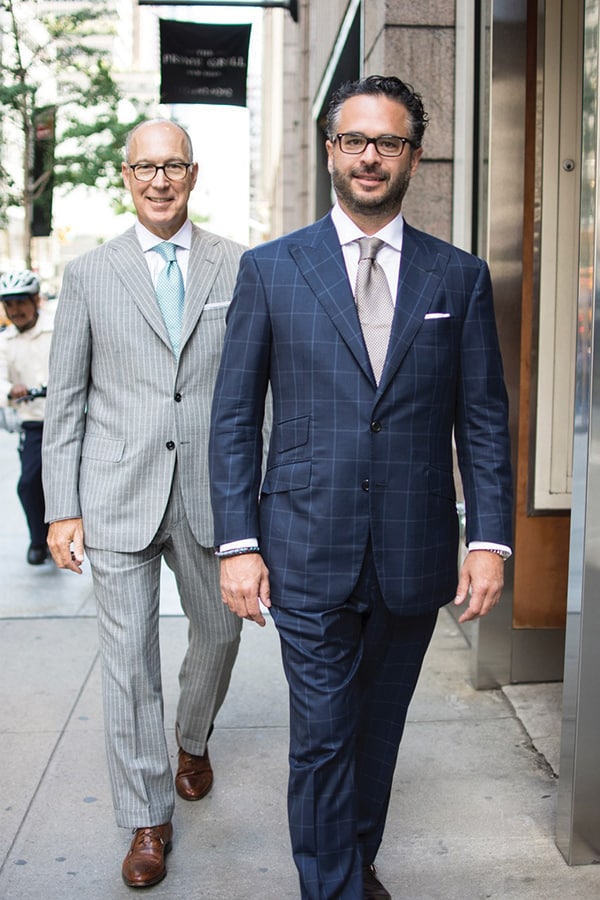OXXFORD CLOTHES SHARES SUCCESS SECRETS AND PLANS FOR THE NEXT 100 YEARS


Here, we speak with Oxxford’s president Bob Denton and sales director Chris Brueckner about how they hit this 100-year milestone, and how they plan to approach the next century.
Q: To what do you attribute the longevity of this highly esteemed luxury brand?
A: Oxxford Clothes’ mission has always been “to create a garment by which all others will be judged.” We have remained true to that mission. We are arguably the only production garment in the United States that is totally made by hand. For example, we allow the artisans who hand-pad our lapels 30 minutes to complete each lapel with approximately 1,000 hand stitches. One person can complete only about seven garments per day. There are 179 steps in the production of an Oxxford suit, which takes approximately 28 hours of labor.
The brand’s longevity is a combination of a couple of things. There is always demand for the best. When Oxxford started, their goal was to make a superior suit. Both retailers and their customers realized there was a difference in an Oxxford garment and it became what everyone measured their tailored clothing against.
The reality today is that many guys have switched to designer and global brands, a more casual style of dress and (lately) made-to-measure and direct-to-consumer clothing. While these trends have been the demise of many tailored clothing companies, Oxxford has been able to adapt to changes, thanks to supportive ownership and a continuing commitment to quality.
Our success can be attributed to maintaining quality, flexibility and growing our consumer base. While our core customer is older, we’re getting lots of interest from younger guys. They’re interested in the “heritage” of the brand, the process of the make, and the customization possibilities. Most can’t do the “spend” yet, but these are our future customers. They want authentic clothing.
Q: So how do you attract younger guys who want Oxxford but can’t afford it?
A: Our social media campaign has dramatically helped raise awareness of Oxxford Clothes with a younger consumer. We have become an aspirational brand for the new generation of gentlemen that appreciates the heritage, artistry and quality of what we produce. Several years ago, an extension brand, Oxxford 1220, was introduced. It’s still a high-quality garment, made in our Chicago factory, but we eliminated some of the more meticulous, time-consuming processes. It changed our ready-to-wear business and did some harm where the end consumer thought he was buying the same Oxxford he had in the past.
All the handwork in an Oxxford garment serves a purpose: it is the only way to put permanent shape into a lapel and collar. And shaping the chest like we do, an Oxxford garment has a give that provides movement that a non-handmade garment cannot claim.
What we do best is make hand-made clothing. It’s who we are, part of our 100 years of success. (We still offer the 1220 product to a few accounts. It’s a great value, but we prefer to focus on our highest quality make.)

Q: How’s current business? What’s selling best?
A: We finished ahead of our forecast for 2016. While we are closely held and do not publicize our numbers, I can say that we remain profitable. We recognized the coming shift several years ago from ready-made clothing to the future demand for more custom and adjusted our production accordingly.
That move set us up to capitalize on the change that has in fact taken place. Ready-made is still an important part of our business: stores must have garments to show and use for fittings. But our production has shifted to mostly custom.
Q: What else do you have planned for this year?
A: For 2017, we won’t stray too far from our classic looks, but we’re focusing on more luxury fabrics in cashmere, and wool/silk blends. We’re reintroducing Escorial wool for both suits and jackets. We now offer more color in jackets and we have a strong presentation in blazer fabrics.
Our new models are slightly trimmer: one is our version of a “soft coat” with a lightweight make and details. The other has a slightly stronger shoulder and narrow waist for a more sartorial expression.
Q: So future growth will come from new product offerings and more custom?
A: Yes, we are growing both with our current retail partners and with new accounts. We have a unique story and product and will continue to focus on what we do best. We also expect to gain market share from competitors who are getting into the retail business and selling directly online, thereby competing with the stores that built up their business for them. I think retailers will be more likely to support brands that are not competing directly with them.
Q: How many wholesale accounts do you have? And why is there just one retail store?
A: We have approximately 90 active wholesale doors. Our flagship in New York is our only company store. Although it’s important for our brand image to have a retail presence in the city, our expertise is making the finest clothing in the world. We are manufacturers. We have a tremendous amount of talent with retail experience within our company; we’d rather use that talent to help our retail partners than to compete with them.
Q: Talk a bit about your new factory location in Chicago? How will this impact production?
A: After 68 years in the same building, we are excited about the move to our new Chicago location. History and nostalgia aside, we’re planning for the next 100 years and this move is an important step. It will enable us to be more efficient, upgrade quality control, and provide a better environment for our employees. Everything will be on one floor, from order processing to pattern making and cutting to sewing and pressing. We anticipate production time will improve, which will be an advantage for our customers. We always welcome customers to visit the factory and see what goes into making our clothing. The new factory will make it easier to view the whole process.
Q: What’s your take on trunk shows: do they still work?
A: Trunk shows do still work, but it’s not about just advertising “this weekend, Oxxford Trunk Show” or calling/emailing a customer “the Oxxford rep will be here this week.” The successful Oxxford trunk shows are ones where store owners and salespeople go above and beyond to get customers in, using it as an opportunity to prospect.
What these smart merchants do is look at their current customer list to determine which guys should be exposed to the next quality level and then invite them in, if only for the education and exposure.
Stores that use our expertise and allow us to do what we do best have great success. We work with all the top mills in the world and bring their books with us to shows; this provides an opportunity to show customers the broadest array of luxury fabrics that they’ll ever see from a single vendor.
Oxxford is also one of the few garments that can generate big volume and profit from a relatively small number of clients: just 15 customers generally generate more than $100,000 in sales with no markdowns. A single Oxxford customer can spend from $20,000 to $90,000+ at a trunk show; these are not atypical numbers for us.
Q: What’s your most expensive Oxxford sale?
A: The most expensive suit that I (Chris) was directly involved in selling was $35,000 (the customer actually purchased two). The fabric was a Super 200’s with a significant mixture of vicuna. We also have a client who purchased several 100 percent vicuna topcoats that I believe retail for about $55,000.



Did he come back,I’m not in business to sell a customer suits. I’m in business to see that he refers me to his friends.and comes back for more.